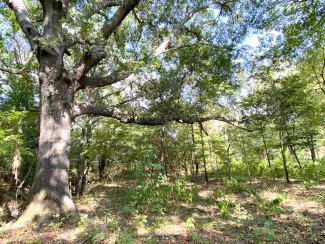If you have hunted wild turkeys in spring, you are likely familiar with the function of roost trees, as you’ve probably set up in early mornings near these sites adjacent to an open field. Roost sites are vital for a turkey on a daily basis as well as on a seasonal basis. In the evenings, turkeys will perch up off the ground where they are protected from predators, then fly down in early mornings. Though turkeys have been known to roost in some pretty creative locations – think rooftops and rafters – they are typically using trees for roosting.

This large red oak would serve as a great roosting tree. It has a wide, open crown with horizontal limbs, an adequately open understory and is located within a riparian zone between a creek and an open field.
When it comes to identifying and maintaining or creating roosts to improve their quality and availability for turkeys, there are some criteria that make a proper and dependable roost tree, and greater roosting site. Ideal roost trees are generally 40 to 50 feet tall with wide, open crowns and ample horizontal limbs. Oaks, sycamores, cottonwoods, pines and pecans are among the tree species in Oklahoma that typically have these characteristics, so the specific tree species used for roosting will vary depending on where you are across the state. In fact, in far western Oklahoma where adequate roost trees may not be available, land managers may opt to install artificial roosts with some success.
It is also imperative that the roost tree have an open understory under the entire canopy of the tree and its vicinity. Even the ‘perfect’ roost tree with all the ideal structural characteristics will be completely avoided if it has a brushy, overgrown understory. This is for two main reasons: 1) Heavy brush or brier thickets under and around the tree create a hazardous or impossible flight onto and off of the roost, and 2) turkeys depend heavily on their vision for predator detection, so if they cannot adequately see the ground and vicinity around the roost tree, they are unable to assess the potential threat of predator ambush upon fly-down.
Location of the roost trees should also be considered within the context of the greater roosting site. During fall, turkeys migrate to winter roosting sites and will spend winter and early spring around these sites keeping a tight range to the area during that time. For this reason, it is necessary for the birds to have relatively close access to cool season food sources like wheat, clover, or cool season native plants; water; and visibly open travel corridors and loafing sites. Continuing into spring and summer, turkeys leave their winter roosting sites, dispersing several miles, so roosting locations can become more sporadic and noncommittal. But regardless of the time of year, the location of any roost site will be situated adjacent to open fields for foraging and strutting, ridges or roads for traveling, or along creeks and rivers.
Watch It on TV!
To landowners and land managers who hope to improve or create roosting sites for wild turkeys: Walk around your property and identify active roost trees or potential roost trees based on the ideal structural characteristics afore mentioned. Then, assess what could be done to improve the area and maximize turkey utilization. Perhaps you need to clear the understory using hand tools or heavy equipment; maybe you need to create a travel corridor near the roost tree or widen an existing travel corridor; or maybe you need to create or better-manage a nearby opening to provide seasonal forage by planting a small winter food plot or conducting a prescribed fire on the opening during different times of year.
Along with the many practices that landowners can implement to provide and maintain quality year-round habitat for our wild turkey populations, managing roost trees is essential. If you need assistance with roost tree identification and management, contact your regional Private Lands Biologist.
